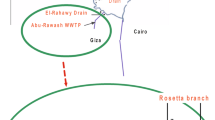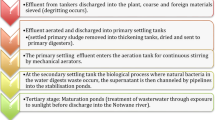Abstract
This study was designed to assess the presence of human adenovirus (HAdV), rotavirus-A (RVA), hepatitis A virus (HAV), and porcine circovirus-2 (PCV2) in groundwater from deep wells, and recreational and network waters. The water samples were collected and concentrated and the virus genomes were assessed and quantified by quantitative PCR (qPCR). Infectious HAdV was evaluated in groundwater and network water samples by integrated cell culture using transcribed messenger RNA (mRNA) (ICC-RT-qPCR). In recreational water samples, HAdV was detected in 100 % (6/6), HAV in 66.6 % (4/6), and RVA in 66.6 % (4/6). In network water, HAdV was detected in 100 % (6/6) of the samples (these 83 % contained infectious HAdV), although HAV and RVA were not detected and PCV2 was not evaluated. In groundwater from deep wells, during rainy period, HAdV and RVA were detected in 80 % (4/5) of the samples, and HAV and PCV2 were not detected; however, during dry period, HAdV and RVA were detected in 60 % (3/5), HAV in only one sample, and PCV2 in 60 % (4/5). In groundwater, all samples contained infectious HAdV. PCV2 presence in groundwater is indicative of contamination caused by swine manure in Concórdia, Santa Catarina, Brazil. The disinfection of human and animal wastes is urgent, since they can contaminate surface and groundwater, being a potential threat for public and animal health.




Similar content being viewed by others
References
AWWA - American water work association (2006) Water Chlorination/Chloramination Practices and Principles. Manual of Water Supply Practices – M20, 2 ed. Denver.
Boffil-Mas S, Albinana-Gimenez N, Clemente-Casares P, Hundesa A, Rodriguez-Manzano J, Allard A, Calvo M, Girones R (2006). Quantification and stability of human adenoviruses and polyomavirus JCPyV in wastewater matrices. Applied and Environmental Microbiology 72:7894–7896
Borchardt MA, Bertz PD, Spencer SK, Battigelli DA (2003) Incidence of enteric viruses in groundwater from household wells in Wisconsin. Appl Environ Microb 9(2):1172–1180
Cheremisinoff NP (2002) Handbook of water and wasterwater treatment technologies. Ed. Butterworth Heinemann, Woburn, MA, USA
Cuthbert JA (2001) Hepatitis A: old and new. Clin Microbiol Rev 14:38–58
Donia D, Bonanni E, Diaco L, Divizia M (2009) Statistical correlation between enterovirus genome copy numbers and infectious viral particles in wastewater samples. Lett Appl Microbiol 50(2):237–250
Espinosa AC, Mazari-Hiriart M, Espinosa R, Maruri-Avidal L, Méndez E, Arias CF (2008) Infectivity and genome persistence of rotavirus and astrovirus in groundwater and surface water. Water Res 42(10–11):2618–2628
Estes MK, Kapikian AZ (2007) Rotaviruses. In: Knipe DM, Howley PM, Griffin DE, Martin MA, Lamb RA (eds) Fields Virology. Lippincott Williams and Wilkins, Philadelphia, pp 1917–1974
Fong TT, Lipp EK (2005) Enteric viruses of human and animals in aquatic environments: health risks, detection, and potential water quality assessment tools. Microbiol Mol Biol R 69(2):357–371
Fongaro G, Nascimento MA, Viancelli A, Tonetta D, Petrucio MM, Barardi CR (2012) Surveillance of human viral contamination and physicochemical profiles in a surface water lagoon. Water Sci Technol 66(12):2682–2687
Fongaro G, Nascimento MA, Rigotto C, Ritterbusch G, da Silva AD, Esteves PA, Barardi CR (2013) Evaluation and molecular characterization of human adenovirus in drinking water supplies: viral integrity and viability assays. Virol J 10:1–9
Fongaro G, Viancelli A, Magri ME, Elmahdy EM, Biesus LL, Kich JD, Kunz A, Barardi CRM (2014) Utility of specific biomarkers to assess safety of swine manure for biofertilizing purposes. Sci Total Environ 479:277–283
Garcia LAT, Viancelli A, Rigotto C, Pilotto MR, Esteves PA, Kunz A, Barardi CRM (2012) Surveillance of human and swine adenovirus, human norovirus and swine circovirus in water samples in Santa Catarina, Brazil. J Water Health 10(3):445–452
Griffin JS, Plummer JD, Long SC (2008) Torque teno virus: animproved indicator for viral pathogens in drinking waters. Virol J 5:112–112
Haramoto E, Kitajima M, Katayama H, Ohgaki S (2010) Real-time PCR detection of adenoviruses, polyomaviruses, and torque teno viruses in river water in Japan. Water Res 44(6):1747–1752
Helmi K, Skraber S, Gantzer C, Willame R, Hoffmann L, Cauchie HM (2008) Interactions of Cryptosporidium parvum, Giardia lamblia, vaccinal poliovirus type 1, and bacteriophages Phi-174 and MS2 with a drinking water biofilm and a wastewater biofilm. Appl Environ Microb 74(7):2079–2088
Hennemann MC, Petrucio MM (2011) Spatial and temporal dynamic of trophic relevant parameters in a subtropical coastal lagoon in Brazil. Environ Monit Assess 181(1–4):347–361
Hernroth BE, Conden-Hansson AC, Rehnstam-Holm AS, Girones R, Allard AK (2002) Environmental factors influencing human viral pathogens and their potential indicator organisms in the blue mussel, Mytilus edulis: the first Scandinavian report. Appl Environ Microb 68(9):4523–4533
Hundesa A, Maluquer de Motes C, Albinana-Gimenez NC, Rodriguez-Manzano J, Bofill-Mas S, Suñen E et al (2009) Development of a qPCR assay for the quantification of porcine adenoviruses as an MST tool for swine fecal contamination in the environment. J Virol Methods 158(1–2):130–135
Jothikumar N, Cromeans TL, Sobsey MD, Robertson H (2005) Development and evaluation of a broadly reactive TaqMan assay for rapid detection of hepatitis A virus. Appl Environ Microb 71(6):3359–3363
Kahler AM, Cromeans TL, Roberts JM, Hill VR (2010) Effects of source water quality on chlorine inactivation of adenovirus, coxsackievirus, echovirus, and murine norovirus. Appl Environ Microb 76(15):5159–5164
Katayama H, Shimasaki A, Ohgaki S (2002) Development of a virus concentration method and its application to detection of enterovirus and norwalk virus from coastal seawater. Appl Environ Microb 68(3):1033–1039
Keevil CT (2003) Rapid detection of biofilms and adherent pathogens using scanning confocal laser microscopy and episcopic differential interference contrast microscopy. Water Sci Technol 47(5):105–116
Ley V, Higgins J, Fayer R (2002) Bovine enteroviruses as indicators of fecal contamination. Appl Environ Microb 68(7):3455–3461
Maluquer de Motes C, Clemente-Casares P, Hundesa A, Martin M, Girones R (2004) Detection of bovine and porcine adenovirus for tracing the source of fecal contamination. Appl Environ Microbiol 70(3):1448–1454
Miranda LAS, Monteggia LO (2007) Sistemas e Processos de Tratamento de Águas de Abastecimento. Porto Alegre: [s.n.].
Nascimento MA, Magri ME, Schissi CD, Barardi CRM (2015) Recombinant adenovirus as a model to evaluate the efficiency of free chlorine disinfection in filtered water samples. Virol J 12:30
Opriessnig T, Yu S, Gallup JM, Evans RB, Fenaux M, Pallares F, Thacker EL, Brockus CW, Ackermann MR, Thomas P, Meng XJ, Halbur PG (2003) Effect of vaccination with selective bacterins on conventional pigs infected with type 2 porcine circovirus. Vet Pathol 40(5):521–529
Page MA, Shisler JL, Mariñas BJ (2010) Mechanistic aspects of adenovirus serotype 2 inactivation with free chlorine. App Environ Microb 76(9):2946–2954
Page MA, Shisler JL, Mariñas BJ (2009) Kinetics of adenovirus type 2 inactivation with free chlorine. Water Res 43(11):2916–2926
Pintó RM, Costafreda MI, Bosch A (2009) Risk assessment in shellfish-borne outbreaks of hepatitis A. App Environ Microb 75(23):7350–7355
Rigotto C, Victoria M, Moresco V, Kolesnikovas CK, Corrêa AA, Souza DSM, Miagostovich MP, Simões CMO, Barardi CRM (2010) Assessment of adenovirus, hepatitis A virus and rotavirus presence in environmental samples in Florianopolis, South Brazil. J App Microbiol 109(6):1979–1987
Rzezutka A, Cook N (2004) Survival of human enteric viruses in the environmental and food. FEMS Microbiol Rev 28(4):441–453
Segalés J, Olvera A, Grau-Roma L, Charreyre C, Nauwynck H, Larsen L et al (2008) PCV-2 genotype definition and nomenclature. Vet Rec 162(26):867–868
Stewart PS, Rayner J, Roe F, Rees WM (2001) Biofilm penetration and disinfection efficacy of alkaline hypochlorite and chlorosulfamates. J Appl Microbiol 91(3):525–532
Suthar S, Chhimpa V, Singh S (2009) Bacterial contamination in drinking water: a case study in rural areas of northern Rajasthan, India. Environ Monit Assess 159(1–4):43–50
Szewzyk U, Szewzyk R, Manz W, Sschleifer KH (2000) Microbiological safety of drinking water. Annu Rev Microbiol 54:81–127
Thurston-Enriquez JA, Haas CN, Jacangelo J, Gerba CP (2003) Chlorine inactivation of adenovirus type 40 and feline calicivirus. Appl Environ Microb 69(7):3979–3985
Viancelli A, Garcia LAT, Kunz A, Steinmetz R, Esteves PA, Barardi CRM (2011) Detection of circoviruses and porcine adenoviruses in water samples collected from swine manure treatment systems. Res Vet Sci 93(1):538–543
Viancelli A, Garcia LAT, SchiochetM KA, Steinmetz R, Ciacci-Zanella JR et al (2012) Culturing and molecular methods to assess the infectivity of porcine circovirus from treated effluent of swine manure. Res Vet Sci 93(3):1520–1524
Zeng SQ, Halkosalo A, Salminen M, Szakal ED, Puustinen L, Vesikari T (2008) One-step quantitative RT-PCR for the detection of rotavirus in acute gastroenteritis. J Virol Methods 153(2):238–240
Author information
Authors and Affiliations
Corresponding author
Additional information
Responsible editor: Philippe Garrigues
Rights and permissions
About this article
Cite this article
Fongaro, G., Padilha, J., Schissi, C.D. et al. Human and animal enteric virus in groundwater from deep wells, and recreational and network water. Environ Sci Pollut Res 22, 20060–20066 (2015). https://doi.org/10.1007/s11356-015-5196-x
Received:
Accepted:
Published:
Issue Date:
DOI: https://doi.org/10.1007/s11356-015-5196-x




